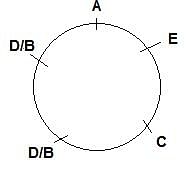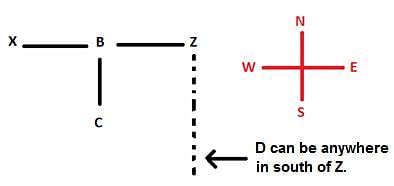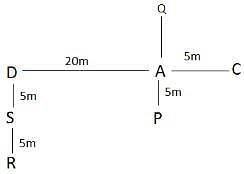Test Level 1: Data Sufficiency - 1 (September 4) - CAT MCQ
10 Questions MCQ Test Daily Test for CAT Preparation - Test Level 1: Data Sufficiency - 1 (September 4)
Directions: This problem consists of a question followed by two statements numbered I and II given below it. Read the statements carefully and decide which of them is/are sufficient/necessary to answer the question.
Mark your answer as
a. if the data in statement I alone is sufficient to answer the question, while the data in statement II alone is not sufficient to answer the question
b. if the data in statement II alone is sufficient to answer the question, while the data in statement I alone is not sufficient to answer the question
c. if the data in either of the statements alone is sufficient to answer the question
d. if the data in both statements I and II together is not sufficient to answer the question
e. if the data in both statements I and II together is necessary to answer the question
Q. Five people A, B, C, D and E sit around a circular table facing the centre. Who sits to the immediate right of D?
I. C sits second to the left of A, who sits adjacent to E.
II. No person sits between D and B.
a. if the data in statement I alone is sufficient to answer the question, while the data in statement II alone is not sufficient to answer the question
b. if the data in statement II alone is sufficient to answer the question, while the data in statement I alone is not sufficient to answer the question
c. if the data in either of the statements alone is sufficient to answer the question
d. if the data in both statements I and II together is not sufficient to answer the question
e. if the data in both statements I and II together is necessary to answer the question
II. No person sits between D and B.
Directions: This problem consists of a question followed by two statements numbered I and II given below it. Read the statements carefully and decide which of them is/are sufficient/necessary to answer the question.
Mark your answer as
a. if the data in statement I alone is sufficient to answer the question, while the data in statement II alone is not sufficient to answer the question
b. if the data in statement II alone is sufficient to answer the question, while the data in statement I alone is not sufficient to answer the question
c. if the data in either of the statements alone is sufficient to answer the question
d. if the data in both statements I and II together is not sufficient to answer the question
e. if the data in both statements I and II together is necessary to answer the question
Q. On which date did Amit celebrate his birthday in October if the year given is same?
I. Amit remembers that his birthday was on the last Monday of October.
II. Amit went to buy clothes on 15th October, which was a Sunday.
a. if the data in statement I alone is sufficient to answer the question, while the data in statement II alone is not sufficient to answer the question
b. if the data in statement II alone is sufficient to answer the question, while the data in statement I alone is not sufficient to answer the question
c. if the data in either of the statements alone is sufficient to answer the question
d. if the data in both statements I and II together is not sufficient to answer the question
e. if the data in both statements I and II together is necessary to answer the question
II. Amit went to buy clothes on 15th October, which was a Sunday.
Directions: This problem consists of a question followed by two statements numbered I and II given below it. Read the statements carefully and decide which of them is/are sufficient/necessary to answer the question.
Q. Who among P, Q, R, S and T has the most number of sweets?
I. P has more sweets than both R and S.
II. Only one person has more sweets than P.
II. Only one person has more sweets than P.
Directions: This problem consists of a question followed by two statements numbered I and II given below it. Read the statements carefully and decide which of them is/are sufficient/necessary to answer the question.
Q. In which direction is point X with respect to point D?
I. Point X is to the west of point B, which is to the north of point C.
II. Point Z is to the north of point D and to the east of point B.
Directions: In this problem, a question is given followed by three statements numbered I, II and III. Read the statements carefully and decide which of them is/are sufficient/required to answer the question.
Q. How much did Ravi score in Computer Science?
I. The average score obtained by Ravi in 4 subjects, including Computer Science, was 65.
II. The score obtained by Ravi in Computer Science and English together was 190.
III. The score obtained by Ravi in English and Maths together was 170.
Directions: In this problem, a question is given followed by three statements numbered I, II and III. Read the statements carefully and decide which of them is/are sufficient/required to answer the question.
Q. A, B, C, D and E are five friends. Their mean age is 14. What is the age of C?
I. A's age is 14 years.
II. B's age is 3 years less than E's age, and E's age is 7 years less than D's age.
III. C's age is 7 years more than B's age and 5 years more than E's age.
Directions: The following problem contains a question and three statements numbered I, II and III. Read the statements carefully and determine which of them is/are sufficient/required to answer the question.
Q. Who is younger between Deepak and Ankit?
I. Deepak is 5 years older than Manish, who is 3 years younger than Kapil.
II. Ankit is older than Kapil.
III. Balkishan is the oldest in the whole group.
Directions: The following problem has a question and statements labelled I, II and III. You have to decide which of the following statements is/are sufficient to answer the question.
Q. Among football, hockey, chess and badminton, which sport does Balkishan play?
I. He plays at least two sports.
II. If the sports are written in an alphabetical order, then he does not play the sports at the extreme ends.
III. He plays exactly two sports.
Directions: In the following problem, a question followed by three statements (I), (II) and (III) is given. You have to determine which statement(s) is/are sufficient/necessary to answer the question.
Q. How far and in which direction is D with respect to Q?
I. R is 10 m to the South of D, who is 5 m to the North of S.
II. D is 20 m to the West of A, who is to the South of Q.
III. P is 5 m to the South of A, who is 5 m to the West of C, who is to the Southeast of Q.
Directions: In this problem, a question is given followed by three statements numbered I, II and III. Read the statements carefully and decide which of them is/are sufficient/required to answer the question.
Q. The second Friday of May 2015 fell on which date?
I. 29th was the last Friday of that month.
II. The last day of that month was a Sunday.
III. There were 5 Fridays in May-2015.
|
152 docs|327 tests
|





















